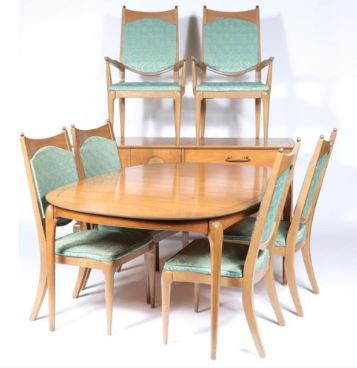Identification and Price guides for Antiques & Collectibles


ANTIQUE FURNITURE: A Collector's Guide
Join the most updated and complete collectibles research online - Learn more...
 Antique furniture has a timeless beauty that captures the imagination of those who appreciate its craftsmanship and historical significance. From intricately carved wooden chairs and tables to elegant cabinets and sideboards, antique furniture pieces are not just functional items but also works of art that reflect the styles and traditions of different periods and cultures. In this article, we will explore the world of antique furniture, its history, its various styles, and how to identify and appreciate its unique characteristics.
Antique furniture has a timeless beauty that captures the imagination of those who appreciate its craftsmanship and historical significance. From intricately carved wooden chairs and tables to elegant cabinets and sideboards, antique furniture pieces are not just functional items but also works of art that reflect the styles and traditions of different periods and cultures. In this article, we will explore the world of antique furniture, its history, its various styles, and how to identify and appreciate its unique characteristics.
Whether you are a seasoned collector or a newcomer to the world of antiques, this article will provide valuable insights into the fascinating world of antique furniture.
Antique furniture not only adds character and charm to a space but can also be a sound investment. As the demand for antique pieces continues to grow, the value of these items often appreciates over time. However, acquiring antique furniture can be a daunting task, and it is essential to have a good understanding of the market and the various factors that influence the value of these pieces. This article will provide useful tips and advice for anyone looking to start collecting antique furniture, including where to find them, how to care for them, and how to authenticate their provenance.
Significant Periods of Antique Furniture
Antique furniture refers to furniture that is at least 100 years old, and it can encompass a wide range of periods, each with its own unique style, from the ornate and elaborate to the simple and understated. Some of the most popular periods of antique furniture include Victorian, Georgian, and Edwardian, each with its own unique characteristics and features, as follows:
- Victorian Furniture Victorian furniture is characterized by its ornate and elaborate design, featuring intricate carvings and embellishments. This style is often associated with the high society of the Victorian era, and it is known for its rich and luxurious materials, such as mahogany and rosewood. Some popular examples of Victorian furniture include chaise lounges, wardrobes, and display cabinets.
- Georgian Furniture Georgian furniture is known for its elegance and simplicity, featuring clean lines and classic proportions. This style emerged during the reign of King George in the 18th century, and it is often associated with the Georgian townhouse. Georgian furniture is typically made of dark woods, such as oak and walnut, and it is known for its high quality craftsmanship and attention to detail. Popular examples of Georgian furniture include dining tables, sideboards, and chests of drawers.
- Edwardian Furniture Edwardian furniture is characterized by its light and airy design, featuring delicate carvings and subtle curves. This style emerged during the reign of King Edward VII in the early 20th century, and it is often associated with the Arts and Crafts movement. Edwardian furniture is typically made of lighter woods, such as oak and maple, and it is known for its refined elegance and attention to detail. Popular examples of Edwardian furniture include dressing tables, bookcases, and armchairs.
One of the key benefits of antique furniture is that it is highly durable and built to last. Many pieces of antique furniture were made by hand, using traditional techniques that have been passed down through generations of craftsmen. As a result, they are often much sturdier and more resilient than modern furniture, which is often mass-produced using cheaper materials and methods.
Another benefit of antique furniture is its unique character and charm. Unlike modern furniture, which is often designed to be mass-produced and uniform, antique furniture is one-of-a-kind and full of personality. Each piece has its own unique history and story to tell, and they can add a sense of warmth and personality to any room.
Of course, there are also some practical considerations to keep in mind when buying antique furniture. For one, it is important to ensure that the piece is in good condition and has been well-maintained over the years. This may require some restoration work, such as refinishing or reupholstering, which should be done by a professional to ensure that the piece is preserved and protected.
It is also important to consider the overall style and design of the piece, and how it will fit into your existing décor. While antique furniture can certainly add a sense of elegance and sophistication to any room, it is important to ensure that it complements your existing furniture and doesn't clash with your overall design scheme.
Ultimately, antique furniture is a timeless investment that can add beauty and style to your home for generations to come. Whether you are looking to add a touch of old-world charm to your living room or create a cozy bedroom retreat, antique furniture can help you achieve your desired look and feel.
When it comes to purchasing antique furniture, there are a few key things to keep in mind. First and foremost, it is important to do your research and understand the history and background of the piece you are interested in. This can help you determine its value and ensure that you are getting a fair price.
It is also important to work with a reputable dealer or seller who can provide you with detailed information about the piece, its condition, and its provenance. This can help you make an informed decision and ensure that you are getting a high-quality piece that will stand the test of time.
In addition to purchasing antique furniture, there are also a number of other ways to incorporate these timeless pieces into your home décor. For example, you could use an antique trunk as a coffee table, or hang an antique mirror above your fireplace to add a sense of elegance and sophistication to your living room.
You could also mix and match antique furniture pieces with more modern furnishings to create a unique and eclectic look. For example, pairing an antique dining table with contemporary chairs can create a stylish and modern dining room that still retains a sense of history and tradition.
Ultimately, antique furniture is a timeless and enduring symbol of style and sophistication. Whether you are a seasoned collector or simply appreciate the beauty and craftsmanship of these pieces, there is no denying their unique charm and appeal. With their durability, unique character, and ability to add warmth and personality to any room, antique furniture is a true investment that will continue to bring joy and beauty to your home for years to come.
Antique Furniture Styles
Antique furniture comes in a wide variety of styles, each with its own unique history, characteristics, and design elements. Some of the most popular antique furniture styles include:
- Victorian: The Victorian era was a time of great innovation and change, and the furniture of this period reflects that. Victorian furniture is characterized by ornate carvings, rich fabrics, and a focus on comfort and luxury. Common materials used in Victorian furniture include walnut, rosewood, and mahogany.
- Chippendale: Named after the famous 18th-century English cabinetmaker Thomas Chippendale, Chippendale furniture is known for its elegant and refined design. Chippendale pieces often feature intricate carvings, flowing lines, and graceful curves, and are typically made from high-quality woods such as mahogany, walnut, and cherry.
- Arts and Crafts: The Arts and Crafts movement emerged in the late 19th century as a reaction against the mass-produced, machine-made furniture of the Industrial Revolution. Arts and Crafts furniture is characterized by its simple, clean lines, natural materials, and focus on functionality over ornamentation.
- Art Deco: The Art Deco style emerged in the 1920s and 1930s and is characterized by its bold geometric shapes, sleek lines, and use of materials such as chrome, glass, and lacquer. Art Deco furniture often features highly stylized motifs and decorative elements, and is typically quite glamorous and luxurious.
- Mid-Century Modern: Mid-century modern furniture emerged in the post-World War II era as a response to the stark austerity of the war years. This style is characterized by its clean lines, simple forms, and use of natural materials such as wood and leather. Mid-century modern pieces often have a sleek and minimalist look, and are highly sought after by collectors and enthusiasts.
Tips for Purchasing Antique Furniture
If you're interested in purchasing antique furniture, there are a few things to keep in mind to ensure that you get the best possible piece for your money. Here are some tips to keep in mind:
- Do your research: Before you start shopping, it's important to do your research and familiarize yourself with the different styles and periods of antique furniture. This can help you identify pieces that are authentic and valuable, and can also help you determine a fair price.
- Shop with reputable dealers: When purchasing antique furniture, it's always a good idea to work with a reputable dealer or seller who can provide you with detailed information about the piece, its history, and its condition: Look for dealers who are knowledgeable about antique furniture and have a track record of providing quality pieces to their customers.
- Check for authenticity: One of the most important things to look for when purchasing antique furniture is authenticity. Be sure to carefully examine the piece for any signs of restoration or repair, and check for markings or labels that can help you identify the maker and date of the piece.
- Consider the condition: While antique furniture can be a great investment, it's important to remember that these pieces are often quite old and may show signs of wear and tear. Be sure to carefully examine the piece for any damage or defects, and consider whether or not you are willing to invest in restoration or repair work.
- Buy what you love: Ultimately, the most important thing when purchasing antique furniture is to buy pieces that you love and that speak to your personal style and taste. Antique furniture can be a wonderful way to add character, charm, and personality to your home, so be sure to choose pieces that you will enjoy for years to come.
Values and Appraising Antique Furniture
Here are some popular categories of Antique and Collectible Furniture from our Price Guide (in alphabetical order):
- Armchairs
- Armoires
- Bedroom Suites
- Bergeres
- Bonheur-du-Jour
- Bookcase
- Buffet
- Bureau
- Cabinets
- Canterbury
- Card Table
- Carlton Desk
- Chaise Longue
- Chaise Lounge
- Chess Table
- Chest of Drawers
- Cheval Mirror
- Coffee Table
- Coffer
- Commode
- Corner-Chair
- Cupboard
- Davenport Desk
- Day-Bed
- Desk
- Display Cabinet
- Dining-Chair
- Dining Table
- Display Table
- Dressing Table
- Dressing Table Mirror
- Dropleaf Table
- Drum Table
- Dumb Waiter
- Fire Screen
- Fireplace
- Floor Lamp
- Frank Lloyd Wright
- Game Table
- Garden Seat
- Grandfather Clock
- Hall Chair
- Library Table
- Longcase clock
- Lowboy
- Mission Style
- Music Cabinet
- Music Stand
- Music Stool
- Oak Bench
- Oak Table
- Occasional Table
- Pembroke Table
- Piano
- Reading-Chair
- Regency
- Rocking-Chair
- Salon Suite
- Satinwood
- Secretaire
- Settee
- Side Chair
- Side Table
- Sideboard
- Sofa
- Storage Trunk
- Sutherland Table
- Table Lamp
- Tallboy
- Tea Table
- Teapoy
- Torchiere
- Travelling Desk
- Tray Table
- Two-Tier Table
- Veneered
- Vitrine
- Wall Mirror
- Wardrobe
- Washstand
- Window Seat
- Writing Table
Conclusion
Antique furniture is a timeless and enduring symbol of style and sophistication that can add warmth, character, and personality to any home. Whether you are a serious collector or just someone who appreciates the beauty and craftsmanship of antique pieces, there is sure to be something out there that speaks to your individual style and taste.
By following the tips outlined in this article, you can ensure that you make an informed and wise purchase when shopping for antique furniture. Whether you're in the market for a classic Victorian sofa or a sleek and stylish mid-century modern armchair, there is an antique piece out there that is perfect for you.
Unlock the true value of your collection with our comprehensive research guides from identifying makers' marks to appraising all kinds of antiques and collectibles, including items featured in this article.
Our up-to-date information will give you an accurate understanding of your items' worth. Don't miss out on this valuable resource - visit our research tools today!
In addition to some examples shown below on this page, you can also search our price guide for your own treasures.
Examples of related items from our Price Guides
-
RARE WALNUT MODEL OF A SHERATON FOLDING FIELD [more like this]
-
REGENCY BURL YEW TILT-TOP CENTER TABLEWith [more like this]
-
A GROUP OF APPROXIMATELY 20 BOOKS RELATING [more like this]
-
THEODORE ALEXANDER WASHINGTON CHEST, CHARLES [more like this]
-
QUÉBEC PINE BONNET CHESTA pine bonnet chest [more like this]
-
TWO SHELVES OF BOOKS MOSTLY RELATING TO ANTIQUE [more like this]
-
TWO PIECES OF MINIATURE ANTIQUE FURNITURETwo [more like this]
-
A GERMAN TULIPWOOD AND VARIOUS WOODS INLAID [more like this]
-
A VICTORIAN LACQUERED AND CARVED BAMBOO DRESSING [more like this]
-
A WILLIAM & MARY PARQUETRY INLAID WALNUT [more like this]
-
A REGENCY FLAME MAHOGANY INLAID SIDEBOARD, [more like this]
-
A PAIR OF RÉGENCE MARBLE TOPPED AND ORMOLU [more like this]
There are many more auction results available to our members...
Explore more items from our
Antiques & Collectibles Price Guide
This list is limited to only a few results.
Many more items are available to our members through our
Price Guides!






